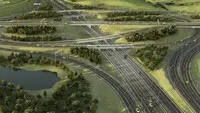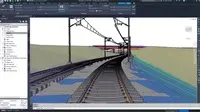Overview
What is Civil 3D?
Autodesk's Civil 3D is a computer aided design (CAD) application designed to support a variety of civil infrastructure projects including rail, roads and highways, land development, airports, drainage, storm and sanitary, and civil structures.
Pricing
Entry-level set up fee?
- No setup fee
Offerings
- Free Trial
- Free/Freemium Version
- Premium Consulting/Integration Services
Starting price (does not include set up fee)
- $335 per month
Product Details
- About
- Integrations
- Competitors
- Tech Details
- FAQs
What is Civil 3D?
Autodesk’s Civil 3D is a civil engineering design tool for engineers, architects, and designers, featuring tools to improve drafting, design, and construction documentation. The tool supports the design and visualization of an array of projects, like rails, bridges, pipes and sanitary systems, corridors, and works with a variety of surfaces and sites.
Civil 3D is available standalone with a number of licensing options. It is also available as part of Autodesk’s Architecture, Engineering & Construction (AEC) Collection, a solution that includes Civil 3D with other CAD and BIM tools including Revit, AutoCAD, InfraWorks, and Navisworks Manage, in a discounted bundle for engineering and construction firms. This package also includes professional grade support and unlimited cloud storage for project files, and all the applications in a common data environment.
Many of Civil 3D’s features are enhanced or completed by inclusion in the AEC Collection. For instance, users can conduct grading design studies based on project constraints. Grading Optimization is available in Civil 3D only as part of the Architecture, Engineering & Construction Collection. Project Explorer is also an extension available in Civil 3D through the AEC collection, and enables users to simplify design review and modification and validate design objectives.
On its own, Civil 3D does support various design projects; popularly, road design can be done in Civil 3D with what the vendor describes as dynamic, flexible 3D models of road corridors that enable users to simulate driving and evaluate sight distance, as well as manage road rehabilitation projects and drainage design. Civil 3D also supports surface modeling, stormwater and wastewater analysis, and the software enables users to download, create, analyze, and adjust survey data, and conduct topographical and terrain modeling.
Autodesk announced expansions to the AEC Collection, including the additions of updated collaboration, project management, and document management tools, particularly Autodesk Docs, a document management tool available exclusively through the AEC Collection to improve approval workflows and data management, and an updated BIM Collaborate and BIM Collaborate Pro, presented as a tool to help teams execute on design.
Civil 3D Features
- Supported: Collaborative Working Environment
- Supported: Bridge Design
- Supported: Surface Modeling
- Supported: Railway Design
- Supported: Road Design (materials, intersections, road rehabilitation)
- Supported: Site & Survey
- Supported: Corridor Modeling
- Supported: Storm & Sanitary
- Supported: Plan Production & Documentation
- Supported: IFC Import & Export
Civil 3D Screenshots
Civil 3D Video
Civil 3D Integrations
- Revit
- Navisworks
- AutoCAD
- ArcGIS
- Autodesk 3ds Max
- InfraWorks
- ReCap Pro
- Dynamo for Civil 3D
Civil 3D Competitors
Civil 3D Technical Details
| Deployment Types | On-premise, Software as a Service (SaaS), Cloud, or Web-Based |
|---|---|
| Operating Systems | Windows |
| Mobile Application | No |





